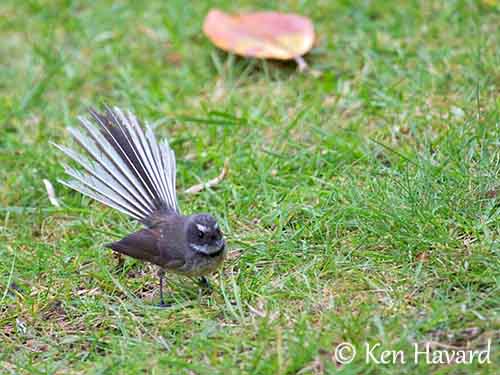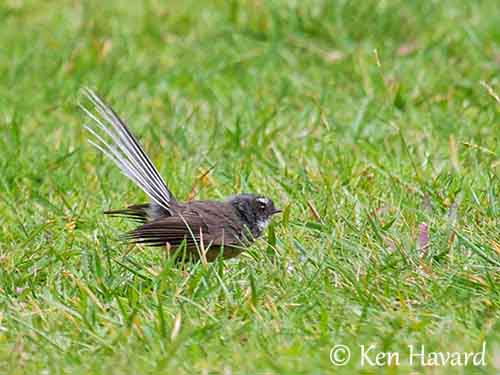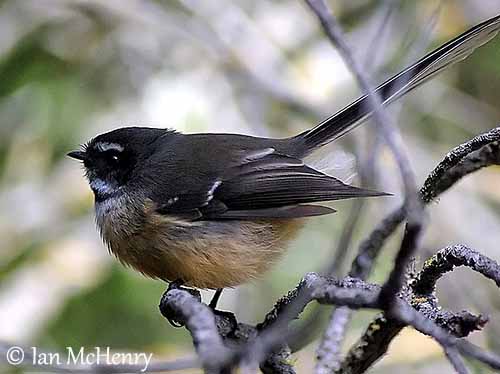
Fr: Rhipidure à collier
Ang: New Zealand Fantail
Maori: Piwakawaka
All: Neuseelandfächerschwanz
Esp: Abanico Maorí
Ita: Codaventaglio delle mangrovie
Nd: Maoriwaaierstaart
Sd: Nya Zeelandsolfjäderstjärt
Photographers:
Ken Havard
My Bird Gallery & Flickr gallery 1 & Flickr gallery 2
Ian McHenry
My New Zealand Birds
Simon Tan
PBase Bird galleries
Text by Nicole Bouglouan
Sources:
HANDBOOK OF THE BIRDS OF THE WORLD Vol 11 by Josep del Hoyo, Andrew Elliott and David Christie - Lynx Edicions - ISBN: 849655306X
KNOW YOUR NEW ZEALAND BIRDS by Lynnette Moon - New Holland Publishers – ISBN: 1869660897
BirdLife International (BirdLife International)
New Zealand bird status between 2008 and 2012
New Zealand birds and birding (Narena Olliver)
Wikipedia, the free encyclopaedia
Te Ara – The Encyclopedia of New Zealand
Home page
Page Passeriformes Order
New Zealand Fantail
Rhipidura fuliginosa
Passeriformes Order – Rhipiduridae Family
INTRODUCTION:
The New Zealand Fantail was named « this fairy of the bush » by William Herbert Guthrie-Smith, naturalist and birdwatcher born in 1862 in Scotland.
This pretty bird is moving continuously and the long, flickering fanned tail is constantly used in flight, during displays and while foraging and feeding.
It is mainly a forest species, but it is well-adapted to human developments and has become quite confiding. Its local Maori’s name is “Piwakawaka”.
DESCRIPTION OF THE BIRD:
Biometrics:
Length: 14-17 cm
Weight: 6,5 - 9 g
There are two colour morphs. The pied morph (here displayed) is more common than the black morph which is about 12/25% of South I population, and less than 1% of North I birds.
The adult male of nominate race has olive-brown upperparts. The upperwing is dark brown with double white wingbar formed by the whitish tips of greater and median wing-coverts. The inner secondaries are edged whitish too. On the uppertail, the central rectrices are brownish-black and show white shafts and tips. The tail feathers 2-5 are white, with brownish-black edges to outer webs. The outer rectrices are greyish-white.

On the underparts, chin and throat are greyish-white, and we can see a sooty-grey breast band on the upper breast forming a dark collar giving the bird its French name. Rest of underparts is pale rusty-buff.
On the head, the forehead is sooty-black, whereas crown, nape, upper cheeks and ear-coverts are dark greyish-black. The face is grey-black with darker lores and white supercilium.
The bill is black with pale base to lower mandible. The eyes are dark brown. Legs and feet are blackish.
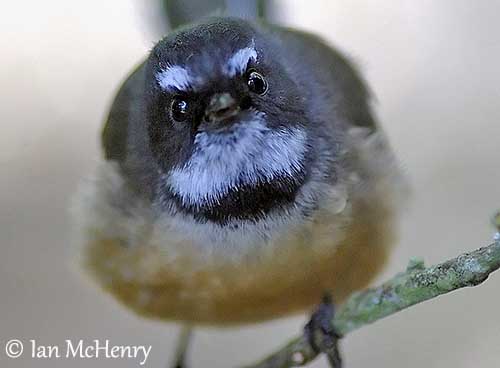
The New Zealand Fantail of black morph has grey-black head and nape, and black upperparts. We can see a small white postocular white spot, usually larger in male, and sometimes extending below the eye. The wings are dark brown with rusty-black wash on wing-coverts. The tail is black. The underparts are brown, with greyish-black throat.
The female resembles male, but she is smaller with paler plumage.
The immature resembles respective adults. The pied morph has paler face with buffy supercilium. On upperparts and wing-coverts, the feathers are tipped rusty.
The black morph has rufous-brown supercilium and feathers tipped rusty-brown on body and wing-coverts.
The juvenile of both morphs is duller than adults with washed and tipped buff-rufous feathers.
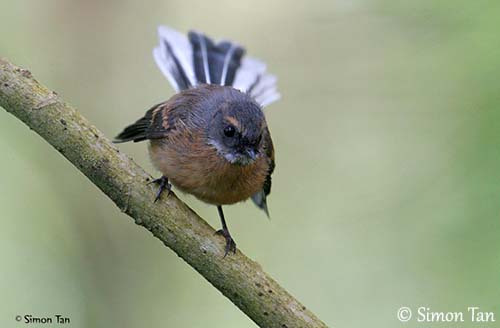
SUBSPECIES AND RANGE:
There are three recognized subspecies. The fourth race “R.f. cervina” from Lord Howe Island is extinct since 1920s.
R.f. placabilis occurs in N New Zealand, including North I and adjacent islands. The pied morph of this race is slightly paler than nominate. On the tail, the white is only visible on tips of central rectrices. The dark morph is like nominate.
R.f. fuliginosa (here described) occurs in S New Zealand including South I, Stewart I and adjacent islands.
R.f. penita is found in Chatham Islands. This one has central rectrices broadly tipped white, and the rectrices 2-5 show a broad white band between the shaft and the black edge of the outer webs.
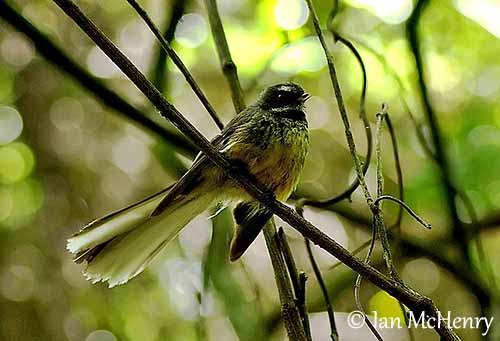
HABITAT:
The New Zealand Fantail is mainly a forest bird. It usually frequents a variety of wooded habitats such as both native and exotic forests where the species is widespread, especially in extensive native forest patches. It is also seen in scrubland, exotic plantations, orchards and wooded suburban parks and gardens.
In New Zealand, it can be seen from the coast to 1500 metres of elevation. Outside the breeding season, it leaves higher elevations to drier habitats.
CALLS AND SONGS: SOUNDS BY XENO-CANTO
The New Zealand Fantail is quite vocal except in cold temperatures. The contact call is “cheet” or “cheep”, given when foraging or if threatened. It utters rhythmical twitters and squeaky chattering “tweeta-tweeta-tweeta…” It sings especially during the breeding season, but this species can be heard all year round.
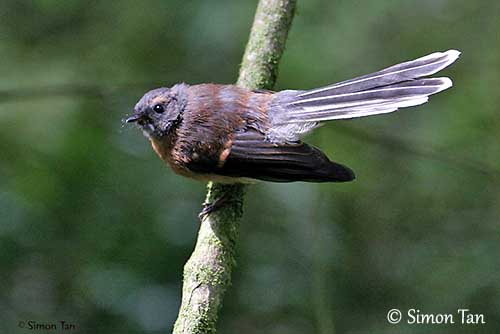
BEHAVIOUR IN THE WILD:
The New Zealand Fantail feeds on small invertebrates such as moths, flies, wasps, beetles and mosquitoes, usually taken on the wing. It also takes spiders. The large preys are held against a perch with the claws, and are repeatedly pecked.
The bird hunts by moving upside down among the foliage or along tree-fern fronds. It catches insects hidden on the underside of leaves. It uses its fanned tail to disturb insects in the foliage. It also forages on the ground among the leaf litter, and can eat small fruits sometimes.
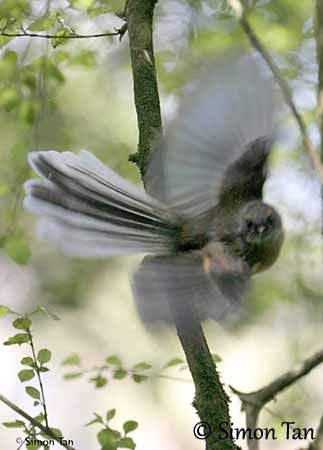
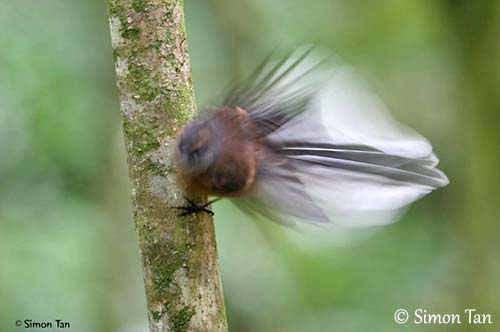
REPRODUCTION OF THIS SPECIES:
The breeding season varies depending on the range, usually August/March in North I, September/January in South I, and late October/late December in Chatham Islands.
This species often produces 2-5 broods, according to the location. They are solitary nesters.
The female builds the distinctive nest, a circular cup made with fine materials such as mosses, dried wood fibres, dried grasses, hair and fern scales. These materials are held together with spiders’ web, and woven across small branches. We can see tapering tails of materials hanging from the base of the cup.
The nest is placed in fork and frond of tree-ferns, usually near water or leaning over a stream.
During the breeding season, the New Zealand Fantail is territorial and chases the intruders away while giving harsh chattering calls. Rivals perform parallel flights along the boundaries of the territory, and then, they perch and display while facing each other.
During the courtship displays, the male struts and performs aerial turns during which the long tail is widely fanned to expose the black-and-white pattern. Courtship feeding from male to female is observed during pair-formation and nest-building. The male also displays from perch and sings loudly.
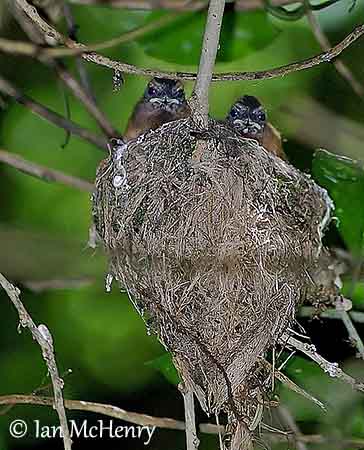
The female lays 2-5 pale eggs with darker spots. Both parents take turns while sharing the incubation during two weeks. Then, the chicks are brooded and fed by both adults during 14 days. The fledglings have short tail. They often perch together side by side. The male cares them while the female starts a new nest for the next brood.
PROTECTION / THREATS / STATUS:
The New Zealand Fantail is usually common in forested areas in New Zealand and adjacent islands. As they have adapted to human developments, the population is stable or increasing, although there are some declines in highly urbanized areas, and after prolonged periods of cold or hard weather conditions.
Predation by introduced species including rats, cats, possums (Trichosurus vulpecula) and Common Myna is an important threat for eggs, chicks and adults.
The Chatham population is abundant but with very variable numbers and restricted range. The global population is not quantified, but this species is common to locally abundant, and it is currently evaluated as Least Concern.
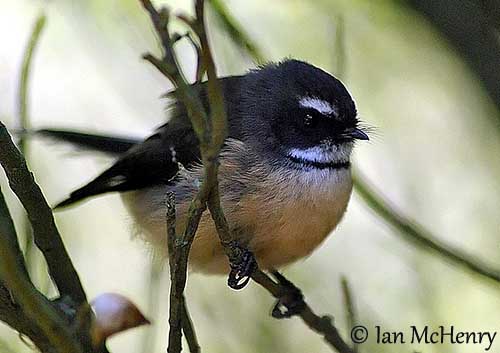
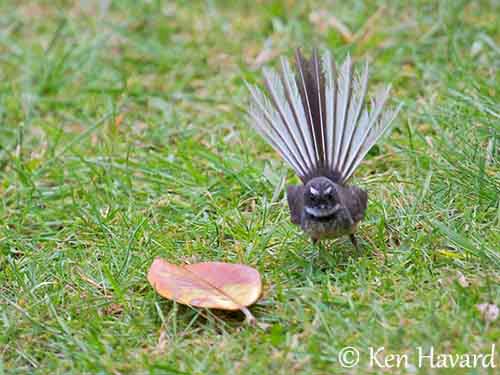
During cold periods, several birds often roost communally and perch tightly together in the shelter of cavities. Outside the breeding season, they may form large flocks of 20-200 individuals in lowlands.
The New Zealand Fantail is mainly resident, except the post-breeding altitudinal movements from highlands to lower areas. It is sedentary in Chatham Islands.
The flight is agile and the bird can move easily in the air, twisting and turning while catching insects, thanks to its tail.
